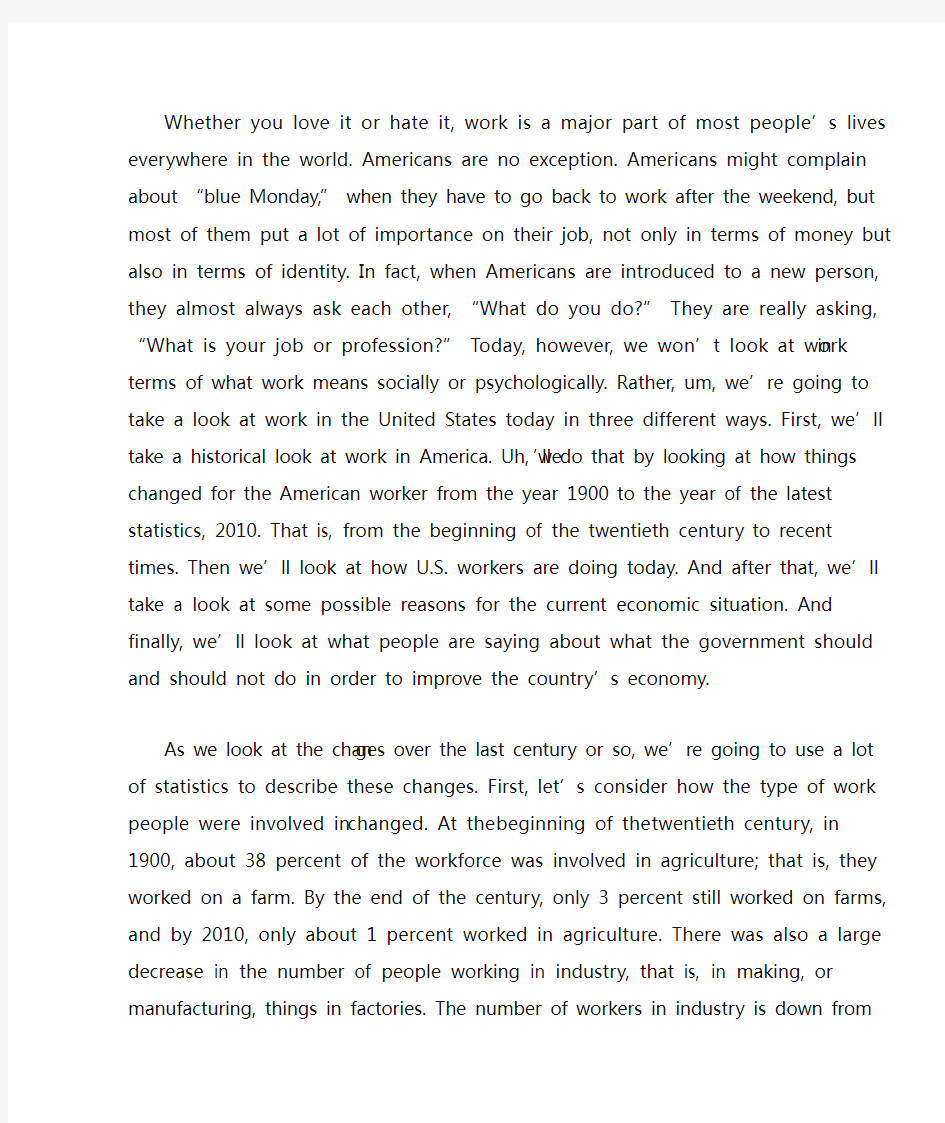新世纪大学英语(第二版)学术英语视听说教程 第2册 Unit3_听力原文.doc

- 1、下载文档前请自行甄别文档内容的完整性,平台不提供额外的编辑、内容补充、找答案等附加服务。
- 2、"仅部分预览"的文档,不可在线预览部分如存在完整性等问题,可反馈申请退款(可完整预览的文档不适用该条件!)。
- 3、如文档侵犯您的权益,请联系客服反馈,我们会尽快为您处理(人工客服工作时间:9:00-18:30)。
Whether you love it or hate it, work is a major part of most people’s lives everywhere in the world. Americans are no exception. Americans might complain about “blue Monday,” when they have to go back to work after the weekend, but most of them put a lot of importance on their job, not only in terms of money but also in terms of identity. In fact, when Americans are introduced to a new person, they almost always ask each other, “What do you do?” They are really asking, “What is your job or profession?” Today, however, we won’t look at work in terms of what work means socially or psychologically. Rather, um, we’re going to take a look at work in the United States today in three different ways. First, we’ll take a historical look at work in America. Uh, we’ll do that by looking at how things changed for the American worker from the year 1900 to the year of the latest statistics, 2010. That is, from the beginning of the twentieth century to recent times. Then we’ll look at how U.S. workers are doing today. And after that, we’ll take a look at some possible reasons for the current economic situation. And finally, we’ll look at what people are saying about what the government should and should not do in order to improve the country’s economy.
As we look at the changes over the last century or so, we’re going to use a lot of statistics to describe these changes. First, let’s consider how the type of work people were involved in changed. At the beginning of the twentieth century, in 1900, about 38 percent of the workforce was involved in agriculture; that is, they worked on a farm. By the end of the century, only 3 percent still worked on farms, and by 2010, only about 1 percent worked in agriculture. There was also a large decrease in the number of people working in industry, that is, in making, or manufacturing, things in factories. The number of workers in industry is down from over 30 percent in 1900 to just over 22 percent in 2010.
While the number of people in agriculture and manufacturing industries went down, the number of people in the services went up. As you may know, services, rather than goods or products, provide other less concrete things that people need. A few examples include education, health care, transportation, tourism, banking, advertising, and legal services. Cafes, restaurants, and fast-food outlets like McDonald’s are part of the service sector, as are retail sales jobs, driving taxis, and pumping gas. The services workforce jumped from 31 percent of the workforce in 1900 to 77 percent in 2010.
Let’s recap the numbers: in 1900, 38 percent in agriculture; 31 percent in industry; and 31 percent in services. In 2010, about 1 percent in agriculture; 22 percent in industry; and 77 percent in services.
To put things into perspect ive, let’s compare the United States today to China, where the picture is very different. From your experience, would you expect China to have more workers in agriculture or in industry? Well, it may or may not surprise you, but in China, agriculture takes up only 10 percent of the workforce, industry a huge 47 percent, and services 43 percent. Figures for the entire world are somewhere between China’s and the United States’ figures: 6 percent, 31 percent, and 63 percent for agriculture, industry, and servi ces, respectively. Let’s get back to the changes in the U.S. workforce in the last century or so.
